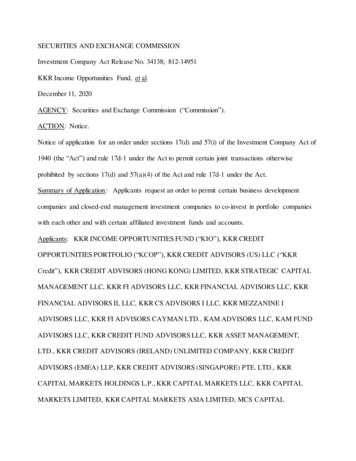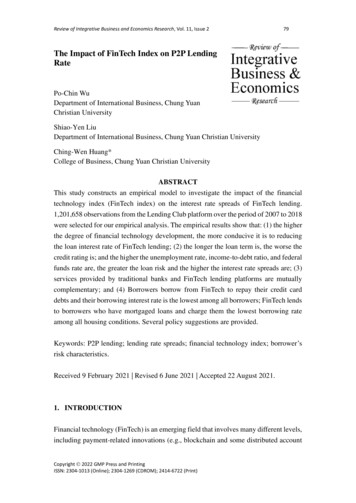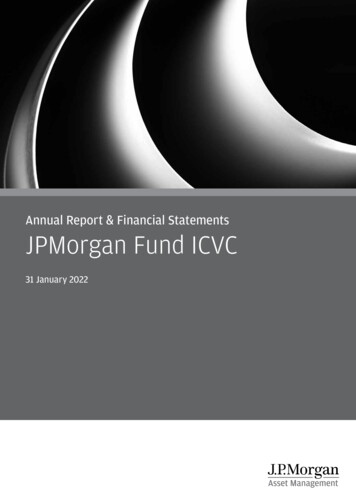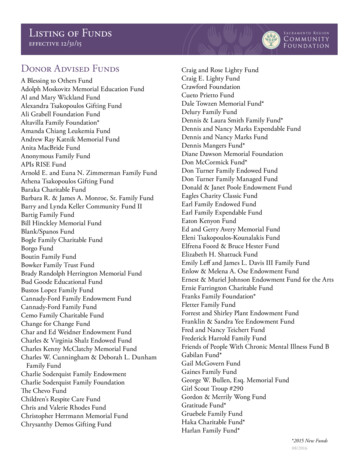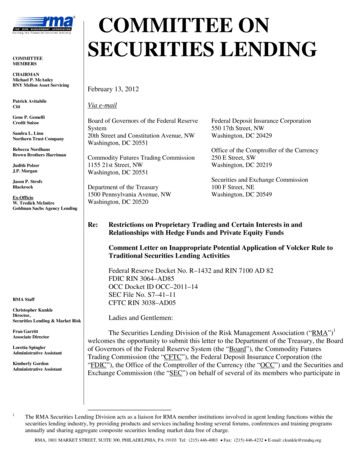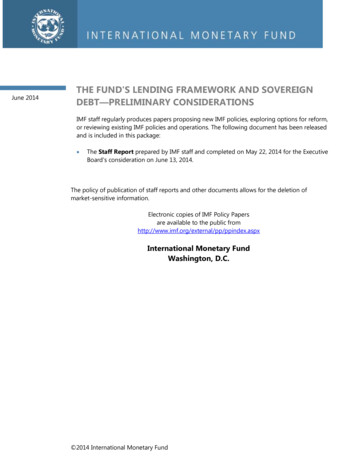
Transcription
June 2014THE FUND'S LENDING FRAMEWORK AND SOVEREIGNDEBT—PRELIMINARY CONSIDERATIONSIMF staff regularly produces papers proposing new IMF policies, exploring options for reform,or reviewing existing IMF policies and operations. The following document has been releasedand is included in this package: The Staff Report prepared by IMF staff and completed on May 22, 2014 for the ExecutiveBoard's consideration on June 13, 2014.The policy of publication of staff reports and other documents allows for the deletion ofmarket-sensitive information.Electronic copies of IMF Policy Papersare available to the public ernational Monetary FundWashington, D.C. 2014 International Monetary Fund
May 22, 2014THE FUND’S LENDING FRAMEWORK AND SOVEREIGNDEBT—PRELIMINARY CONSIDERATIONSEXECUTIVE SUMMARYBackground. As a follow-up to the Executive Board's May 2013 discussion, this paperconsiders a possible direction for reform of the Fund's lending framework in the contextof sovereign debt vulnerabilities. The primary focus of this paper relates to the Fund'sexceptional access framework, since it is in this context that the Fund will most likelyhave to make the difficult judgment as to whether the member's problems can beresolved with or without a debt restructuring. The objective of the preliminaryapproaches set forth in this paper is to reduce the costs of crisis resolution for bothcreditors and debtors—relative to the alternatives—thereby benefitting the overallsystem. These ideas are market-based and their eventual implementation would requiremeaningful consultation with creditors.Nature of the problem. The Exceptional Access Framework established in 2002 (“2002framework”) limits the range of policy responses available to the Fund when a memberseeks financing above normal access limits in the context of a sovereign debt crisis.Specifically, under the 2002 framework, if the Fund determines that the member’s debtis sustainable with high probability, it may provide large scale financing without theneed for a debt restructuring. However, if such a determination cannot be made,exceptional access may only be provided if a debt restructuring is pursued that issufficiently deep to restore sustainability with high probability. While the 2002framework was designed to address concerns regarding both moral hazard and thecost of delaying the restructuring of unsustainable debt, this paper concludes that italso created scope for unnecessary costs for both the debtor and its creditors, since itrequires a definitive debt restructuring even in circumstances where, in the end, it mightnot be needed.Possible remedy. The preliminary ideas in this paper would introduce greater flexibilityinto the 2002 framework by providing the Fund with a broader range of potential policyresponses in the context of sovereign debt distress, while addressing the concerns thatmotivated the 2002 framework. Specifically, in circumstances where a member has lostmarket access and debt is considered sustainable, but not with high probability, theFund would be able to provide exceptional access on the basis of a debt operation thatinvolves an extension of maturities (normally without any reduction of principal orinterest). Such a “reprofiling” operation, coupled with the implementation of a credibleadjustment program, would be designed to improve the prospect of securingsustainability and regaining market access, without having to meet the criterion ofrestoring debt sustainability with high probability.
THE FUND’S LENDING FRAMEWORK AND SOVEREIGN DEBTSafeguarding the catalytic role. The possible modifications would preserve theeffectiveness of the Fund’s traditional catalytic role—there would be no presumptionthat a reprofiling would be required simply because a member seeks Fund support.Rather, a reprofiling would be envisaged only when both (a) a member has lost marketaccess and (b) debt is assessed to be sustainable, but not with high probability.Conversely, in circumstances where a member’s debt is unsustainable, a reprofilingwould be inappropriate and an upfront debt reduction operation would be pursued, asunder current policy. A debt reduction would also be called for if a reprofiling operationfailed to dispel concerns regarding debt sustainability—i.e., repeat reprofilings wouldbe avoided.Benefits. Where there is considerable uncertainty as to whether debt is sustainable orunsustainable, a reprofiling will generally be less costly to the debtor and creditors—and thus to the system overall—relative to either an upfront debt reduction operationor a bail-out that is followed by debt reduction. Moreover, relative to a bail-out, thefinancing that will be provided through the reprofiling could allow for more gradualadjustment paths, which would help growth, reduce economic dislocation and facilitatesuccessful program implementation.Securing creditor support. As with other types of debt restructuring supported by theFund, a reprofiling will be market-based. Accordingly, a reprofiling would require thesovereign’s creditors to agree to amend the terms of the instruments to extendmaturities. Creditors will only agree if they understand that such an amendment isnecessary to avoid a worse outcome: namely, a default and/or an operation involvingdebt reduction. This will require consultation with creditors, including an explanation ofthe assumptions that underpin the member’s debt sustainability analysis. Collectiveactions clauses, which now exist in most—but not all—bonds, would be relied upon toaddress collective action problems. Official creditors would be expected to maintaintheir exposure either through an extension of maturities or provision of new financing.Systemic exemption. Under the possible modifications, the systemic exemption to the2002 framework that was introduced in 2010 would be eliminated. The exemption isperceived to be inequitable and excessively open-ended. Moreover, experiencedemonstrates that, since contagion is exacerbated by uncertainty, a large scale bail-outthat fails to address underlying concerns regarding sustainability will not mitigatecontagion risks. It is recognized that there may be circumstances where any form ofdebt restructuring—an upfront debt reduction or a reprofiling—would be consideredproblematic from a contagion perspective. The paper considers that, in these cases,sustainability concerns could be addressed not through a debt restructuring butthrough concessional assistance provided by other official creditors.Ex ante effects. Since the revised framework would continue to rely on case-by-casejudgments on the extent to which a member’s debt is sustainable or unsustainable, theimpact of the possible reforms will largely depend on how they are applied in practice.It is unlikely that the possible modification would affect countries’ steady-state2INTERNATIONAL MONETARY FUND
THE FUND’S LENDING FRAMEWORK AND SOVEREIGN DEBTborrowing costs, since investors tend to rely primarily on the creditworthiness of theborrower when pricing risk. However, in the context of debt distress of a particularmember, it is possible that creditors may demand higher rates on shorter-term debt ifthey perceive that the modifications would reduce the probability of a bail-out. If this isthe case, it can be seen as a healthy development since it will lead to a better pricing ofrisk.Normal access. Although many of the benefits from reprofiling may apply equally innormal access cases when debt sustainability is in doubt, the paper does not considermaking it a requirement in normal access cases where there is uncertainty regardingdebt sustainability. The paper suggests, however, that a policy be established to avoidthe repeated use of reprofilings in normal access cases, in line with the approachconsidered under exceptional access. If a reprofiling does not work, it would suggestthat a definitive solution to the member's debt problem is called for.INTERNATIONAL MONETARY FUND3
THE FUND’S LENDING FRAMEWORK AND SOVEREIGN DEBTApproved byOlivier Blanchard,Sean Hagan,Siddharth Tiwari,and José ViñalsThis paper was prepared by a team from four departments led byReza Baqir. The team comprised Yan Liu (LEG lead), Julianne Ams,Wolfgang Bergthaler, Chanda DeLong, Nikita Aggarwal, Hoang Pham,Gomi Otokwala, and Natalia Stetsenko (all LEG); Luc Everaert (MCMlead), Michael Papaioannou, Miguel Segoviano, Kay Chung, AnastasiaGuscina, and Gabriel Presciuttini (all MCM); Luc Laeven (RES lead),Marcos Chamon, Raquel Fernandez, Alberto Martin, Romain Ranciere,and Damiano Sandri (all RES); and Geneviève Verdier and VarapatChensavasdijai (SPR leads), Athanasios Arvanitis, Tamon Asonuma,Alexander Culiuc, Christopher Dielmann, Heiko Hesse, Sarwat Jahan,Charlotte Lundgren, Alex Pienkowski, Francisco Roch, Stephanie Segal,Cesar Serra; Preya Sharma, Nelson Sobrinho, Yan Sun-Wang, SuchananTambunlertchai, and Yi Xiong (all SPR). The work was supervised byOlivier Blanchard, Sean Hagan, Hugh Bredenkamp, and Peter Dattels.CONTENTSI. INTRODUCTION 6II. THE FUND’S EXCEPTIONAL ACCESS FRAMEWORK—UNDERSTANDING THE PROBLEM ANDTHE OBJECTIVES OF POTENTIAL REFORM 8A. The nature of the problem 8B. A possible remedy 11C. Costs and benefits of the possible remedy 12D. Addressing contagion concerns 18E. Potential ex ante effects 21III. DESIGN AND IMPLEMENTATION ISSUES 22A. When should a reprofiling take place? 22B. The length of the reprofiling period and the scope of debt to be covered 25C. The design of the Fund-supported program 26D. Securing creditor support 27E. Resolving collective action problems 29F. Implications for the normal access framework 31G. Clarifying the market access criterion 32IV. ISSUES FOR DISCUSSION 32References 414INTERNATIONAL MONETARY FUND
THE FUND’S LENDING FRAMEWORK AND SOVEREIGN DEBTBOXES1. Exceptional Access Criteria 332. Relationship Between Creditor Losses and Duration of Market Access Loss 343. Impact of Sovereign Debt Maturity Extensions on Domestic Bank Balance Sheets 354. Debt Reprofiling in Past Fund-Supported Programs 365. Contagion in Past Restructuring and Reprofiling Cases 386. A Framework for Assessing Market Access Loss 40FIGURES1. Median Bond Yields Before and After Restructuring Announcement 152. Length of S&P Selective Default Rating 153. Reprofiling and Face Value Reduction: Time to Market Reaccess 164. Assessment of Debt Sustainability, Market Access, and Fund Lending 24INTERNATIONAL MONETARY FUND5
THE FUND’S LENDING FRAMEWORK AND SOVEREIGN DEBTI. INTRODUCTION1.As a follow-up to the Executive Board’s May 2013 discussion, this paper discusses therelationship between the Fund’s lending framework and sovereign debt vulnerabilities and,in that context, provides preliminary considerations regarding a possible direction forreform.1 A separate paper will examine potential areas of reform in the contractual framework thatwould address collective action problems that may arise in the context of debt restructuring. Thatpaper will be issued for discussion as soon as ongoing consultations with creditors regarding thedesign features of these contractual provisions are complete. As agreed, future work will alsoinclude an examination of official sector involvement in sovereign debt restructuring and a reviewof the Fund’s lending-into-arrears policy.2.The primary focus of this paper relates to the design of the Fund’s exceptional accesspolicy. A member facing a crisis arising from its inability to service its debt typically has largefinancing needs. It is therefore not surprising that it is in the exceptional access context that theFund typically finds itself having to make the difficult judgment as to whether the member’sproblems can be resolved with or without a debt restructuring. Moreover, given the heightened riskto the Fund that arises from the granting of access above the normal limits (“exceptional access”), itis also not surprising that it is in this context that the Fund has sought to identify ex ante criteria toguide its discretion. Indeed, the exceptional access framework established in 2002 sought toprovide both substantive and procedural guidance on how these issues should be considered bythe Fund. While an important element of this framework was modified in 2010, this modificationwas not accompanied by an in-depth assessment of the 2002 framework, and staff is of the viewthat such an analysis is overdue. In particular, and as will be discussed in this paper, the 2010amendments revealed certain rigidities in the 2002 framework that require broader consideration.These rigidities do not exist in the policy governing normal access decisions, and hence the paperconcludes that the possible modification be primarily addressed to exceptional access cases.3.The analysis set forth in this paper has been guided by the Executive Directors’request for staff to “approach these issues with an open mind and pragmatism, finding theright balance between flexibility and predictability.” Consistent with this guidance, the staff hastaken into account several principles that would guide any reform discussions. First, when a member encounters sovereign debt distress manifested by a loss of market access,it is critical that the Fund be in a position to provide large-scale financing in circumstanceswhere it reaches a judgment that a combination of strong adjustment measures and financialassistance from the official sector will restore market confidence and access and enable themember to service its obligations in full. Preserving this traditional catalytic function is critical1See Sovereign Debt Restructuring—Recent Developments and Implications for the Fund’s Legal and Policy Framework.6INTERNATIONAL MONETARY FUND
THE FUND’S LENDING FRAMEWORK AND SOVEREIGN DEBTnot only because it limits economic dislocation and financial instability in the member’seconomy, but also because it has long-term benefits for the stability of the internationalmonetary system, including by protecting the creditor-debtor contractual relationship andpreserving sovereign debt as an important asset class. Accordingly, there should be no hard,pre-specified limits on the amount of financing that can be provided to a member.Furthermore, debt restructuring should not be relied upon in circumstances where the memberis facing a temporary loss of market access and where concerns regarding debt sustainabilityare limited. For all of the above reasons, when a member facing financing pressures approachesthe Fund, there should be no “presumption” that any Fund assistance will be made conditionalupon any form of debt restructuring. Second, when considering how to address problems of sovereign debt sustainability, the Fundshould seek solutions that are least costly to the member, its creditors, and the overall system—and which protect the interests of the Fund as a financial institution. Where debt is sustainablewith high probability, the catalytic approach represents the most effective way of achievingthese objectives. However, in circumstances where debt is unsustainable, a debt restructuringthat restores sustainability should take place as soon as possible. While debt restructuringalways entails costs, delaying a restructuring that is judged to be inevitable will often simplyexacerbate costs. As will be discussed in this paper, a key challenge is how to minimize costs incircumstances where there is uncertainty as to whether a member’s debt is sustainable orunsustainable. Third, when the Fund makes judgments in this area, they should continue to be made on acase-by-case basis—i.e., they should remain judgments. While—as with other policies—it isappropriate that these judgments be based on the application of general criteria established bythe Executive Board, these criteria should be designed to guide—but not eliminate—theexercise of discretion. Finally, there should be adequate creditor consultation during the restructuring process.Creditors will only agree to a restructuring when they understand that it is in their interest to doso. Accordingly, it is important that the Fund support a process whereby creditors haveadequate information with respect to both the nature of the member’s problems and theelements of the Fund-supported program that is designed to address them. While themodalities of this engagement will vary, taking into consideration the circumstances of the case,it is important that there be sufficient transparency, including with respect to the relevant debtsustainability analysis. “Take-it-or-leave-it” offers (i.e., where there is no meaningful consultationwith creditors) should be avoided.INTERNATIONAL MONETARY FUND7
THE FUND’S LENDING FRAMEWORK AND SOVEREIGN DEBT4.It is recognized that balance of payments crises can also arise from over-indebtednessin the banking, corporate and household sectors. The Fund has devoted considerable efforts inhelping the membership design and implement frameworks that restructure the debt of thesesectors. These efforts include not only reforms that are designed to implement the Key Attributes ofEffective Resolution Regimes for Financial Institutions but also reforms of the domestic corporateand household insolvency systems.2 However, while the effective implementation of theseframeworks would help limit the risk that indebtedness in these sectors of the economy will betransferred to the sovereign, they cannot be relied upon to restructure sovereign debt once it hasbecome unsustainable.5.The preliminary ideas set forth in this paper are market-based, and take a differentapproach than the one advanced by the Fund in 2003 for a sovereign debt restructuringmechanism (SDRM). As a means of reducing the costs that arise from unsustainable sovereigndebt, the paper explores a targeted change to the Fund’s lending framework to make it moreflexible and calibrated to members’ debt situations, taking it as given that any associatedrestructuring of debt would take place through market-based mechanisms. Consistent with theabove, while the paper recognizes that collective action problems may complicate the restructuringprocess, it relies on a contractual—rather than statutory—solution to the problem. In preparing thispaper, staff consulted informally with a broad range of market participants. The analysis thatunderpins the following considerations has benefitted from the input of these participants.II. THE FUND’S EXCEPTIONAL ACCESS FRAMEWORK—UNDERSTANDING THE PROBLEM AND THEOBJECTIVES OF POTENTIAL REFORMA. The nature of the problem6.The key elements of the existing exceptional access policy were established in 2002and were designed to address widespread concerns that the Fund’s lending framework hadbeen excessively permissive. Prior to 2002, the exceptional access policy was designed to be veryflexible—and was implemented that way.3 In circumstances where a member sought financing inexcess of the established limits, the Fund had a policy of waiving the limits on the basis of“exceptional circumstances”—with no criteria as to what these circumstances were and why theyshould be considered particularly exceptional. As capital account crises arrived with greater2Available via the Internet: http://www.financialstabilityboard.org/cos/cos 111001a.htm3See Annex I for a historical review of the Fund’s lending framework and exceptional access policy.8INTERNATIONAL MONETARY FUND
THE FUND’S LENDING FRAMEWORK AND SOVEREIGN DEBTfrequency during the 1990s, the Fund found itself invoking the exceptional access policy withgreater frequency: while exceptional access was only granted on rare occasions during the 1980s, itwas granted 14 times between 1995 and 2002 and some of the Fund-supported programs wereunprecedentedly large. Concerns grew within the Fund—and within the official sector moregenerally—that the Fund’s resources were simply being used to enable the sovereign to repaymaturing debt obligations, and that these financing packages were generating moral hazard.Moreover, there was concern that, in some cases, a delay in debt reduction allowed some creditorsto exit, requiring sharper debt reduction later on. Last, but certainly not least, large-scale Fundfinancing in these circumstances called into question the adequacy of safeguards for Fundresources. The Fund’s decision to lend to Argentina in 2001, and the subsequent default of thecountry’s debt, served as the final catalyst for a broad review of the Fund’s exceptional accesspolicy. This review culminated in the 2002 reform.7.Central to the 2002 exceptional access framework is the requirement that “a rigorousand systematic analysis indicates that there is a high probability that the debt will remainsustainable.” The consequences of this requirement are two-fold: First, where exceptional access is sought, the Fund may rely on its traditional catalyticapproach—the provision of financing in a manner that enables the sovereign to service itsoriginal obligations—only where the Fund is very confident that this approach will work; i.e.,where there is a high probability that the member’s debt is sustainable. As a result of thisapproach, debt restructuring will be required not only in cases where there is a high probabilityof unsustainability, but also where it is not clear with a high probability whether the debt issustainable or unsustainable; i.e., in cases where there is uncertainty. Second, in those cases where a determination is made that debt restructuring is necessary, itmust be sufficiently deep to enable the Fund to conclude that, post restructuring, there is a highprobability that the member’s debt will become sustainable. Importantly, therefore, where debtrestructuring is needed, the 2002 framework requires a definitive debt operation; i.e., one thatentails a significant reduction in the net present value of claims.8.In assessing the implications of the above approach, it needs to be recognized that, inthe sovereign context, there will be occasions where there is uncertainty as to whether themember’s debt is sustainable or unsustainable. As noted in the 2013 paper, recentimprovements in the Fund’s DSA framework will help to make sharper judgments with respect todebt sustainability. This will help to ensure that debt restructuring is timely—and sufficient—inthose cases where it is clearly warranted. However, since debt sustainability assessments are notsimply mechanical or data-driven, and because they are forward-looking, they will always requiredifficult judgments regarding a broad range of variables, including, for example, the medium-termgrowth path. Accordingly, no matter how rigorous a DSA is designed to be, there are likely to beinstances where it will be difficult to conclude that there is a high probability of either sustainabilityor unsustainability.INTERNATIONAL MONETARY FUND9
THE FUND’S LENDING FRAMEWORK AND SOVEREIGN DEBT9.Where there is uncertainty regarding debt sustainability, requiring debt restructuringthat is sufficiently deep to restore sustainability with a high probability imposes costs that, inthe end, may not be justified. No matter how orderly a debt restructuring operation is, it willimpose costs. From a creditor’s perspective, these costs are primarily the loss in the net presentvalue of its claims, but also may include any spillover effects to other sovereign bonds or assetclasses. From the sovereign’s perspective, these costs range from a loss of market access over themedium term to disruptions in the financial sector, especially where the sovereign’s debt is held byits banks. From the perspective of global financial stability, there is also the risk of contagion. Incases where a sovereign’s debt is unsustainable, these costs need to be weighed against the costsof delaying a restructuring that has become inevitable. As was stated in the 2013 paper, the Fundhas taken the position that, in such cases, it is in the interests of the sovereign, its creditors, theFund and the overall system for the restructuring to absorb these costs earlier rather than later.However, in circumstances where there is uncertainty as to whether the debt is sustainable orunsustainable, the costs of a debt restructuring that involves a significant NPV reduction need to beassessed against the possibility that such a restructuring may not actually be needed; i.e., that acombination of strong adjustment and Fund financing will enable the member to service itsobligations.10.This problem came to the fore during the Fund’s experience with the euro areaprograms. While the DSAs produced for these members did not conclude that debt wasunsustainable, they were also not able to conclude that the debt was sustainable with a highprobability. Under the terms of the 2002 policy, the only choice for the Fund would have been tocondition Fund support on the implementation of a debt restructuring operation that was ofsufficient depth to enable the Fund to conclude that, post restructuring, the member’sindebtedness would be sustainable with high probability. Out of concern that an upfront debtrestructuring operation would have potentially systemic effects, the Fund opted to amend theframework in 2010 to allow the requirement of determining debt sustainability with “highprobability” to be waived in circumstances where there is a “high risk of international systemicspillovers.”411.It has become clear that the systemic exemption established in 2010 does not providea coherent long-term solution to the problem. The difficulty with the systemic exemption is thatit is both too narrow and too broad. It is too narrow because it is only of benefit to those membersthat are sufficiently large or interconnected that debt reduction will have systemic consequences,whereas the rigidity in the policy potentially affects all members. It is too broad because it does notaddress the key concerns that gave rise to the 2002 framework; namely, in circumstances wherethere is uncertainty regarding the sustainability of a member’s debt, there are costs to a frameworkthat anticipates use of the resources of the Fund—and of the member—for the repayment of4See Box 1 for the four exceptional access criteria that are currently applicable, incorporating the amendment madein May 2010.10INTERNATIONAL MONETARY FUND
THE FUND’S LENDING FRAMEWORK AND SOVEREIGN DEBTmaturing debt obligations to private creditors. As noted in the 2013 paper, in the event that a debtrestructuring is required, this approach simply aggravates the problems for the member and alsoplaces the Fund’s own resources at greater risk. Moreover, because of the limits on the availabilityof financing from the official sector, allowing for creditor exit imposes a greater burden on the fiscaladjustment process, which can undermine medium-term growth prospects and weaken politicalsupport for adjustment, thereby jeopardizing sustainability.B. A possible remedy12.In considering ways to address the above shortcomings, staff has focused on thepossibility of making the 2002 framework more flexible so as to support a broader range ofpolicy responses with regard to sovereign debt. The objective of the possible reform would beto enable the Fund to: (i) help the member improve its capacity to service its debt withoutnecessarily requiring significant debt reduction while (ii) avoiding a situation where,notwithstanding concerns regarding debt sustainability, the program allows for the eventual fullrepayment of maturing obligations to private creditors. The existing systemic exemptionestablished in 2010 would be eliminated and, as is described in Section II.D, alternative approachescould be considered when addressing the risk of contagion that may arise from a debtrestructuring.13.Under the approach considered in this paper, in circumstances where a member haslost market access and public debt is considered sustainable, but not with high probability,the Fund would be able to make its financing conditional upon a debt operation that, whileimproving debt sustainability, does not necessarily restore sustainability with highprobability. Specifically, creditors would be requested to agree to a relatively short extension ofmaturities (“reprofiling”). A reprofiling would typically not involve a reduction in either principal orcoupon and, in light of the fact that it would be of limited duration, would not imply a significantreduction in the net present value of creditors’ claims. Because of its limited nature, such a debtoperation would not necessarily restore debt sustainability with high probability (hence
Executive Board's May 2013 discussion, this paper considers a possible direction for reform of the Fund's lending framework in the context of sovereign debt vulnerabilities. The primary focus of this paper relates to the Fund's exceptional access framework, since it is in this context that the Fund will most likely


